Looking to build the right set of SEO resources for your company?
On December 16, I moderated a Search Engine Journal webinar presented by Jimmy Page and Wes Flippo of Inseev Interactive.
They shared a framework for establishing your ideal SEO resource stack and a supplemental perspective on resource allocation as planning gets underway for 2021.
Here’s a recap of the presentation.

Executing successfully on SEO is a challenge for companies of all shapes and sizes.
Building the right set of resources from day one is the most critical component for success.
For mid-market and enterprise businesses, you’ll need to nail down these three elements to succeed in SEO.
- Allocating limited dollars to the most effective actions.
- Synchronizing complex workflows across multiple skillsets.
- Iterating and innovating towards goals of continuous growth.
The Recipe for SEO Success
SEO is an orchestrated effort across departments, teams, and skillsets.
The greatest challenge is not in knowing how to optimize a website, it’s in getting the right amounts of each of these facets to function together at the right times.
These are the key areas you’ll need to cover in order to execute SEO programs:
- Link development.
- Editorial creative.
- Graphics and rich media.
- UI/UX.
- Web development.
- Analytics and technology.
Establishing dedicated SEO resources for each of these areas is critical.
Here’s an ideal framework for a company’s SEO ecosystem.

Strategists and channel owners need continuous access to the resources on this bottom tier or processes will break down.
Let’s dive into each area’s scope of work.
SEO Strategy
The lead SEO strategist serves as:
- The representative of the channel’s performance to the C-suite.
- The project planner and manager or “orchestrator” of all SEO execution.
- The subject matter expert.
The lead SEO strategist also conducts:
- Monthly deep-dives and strategic alignment to reconfigure the service mix each month.
- Quarterly business reviews (i.e., executive presentations, recap progress, and future actions).
- Annual planning. Repeat the cycle annually, beginning with the annual audit and strategy formulation project
Tools to use:
- DeepCrawl
- Screaming Frog
- STAT
- Moz
- SEMrush
Link Development
Link development is a big part of SEO success as authority metrics still make up the backbone of search engine algorithms.
When looking at this area, we need to remember that link acquisition for a large brand looks different than link acquisition for a mid-market business.
Linking strategy is derived from the strategy team, and communicated outwardly to outsourced partners or internal teams.
Tools to use:
- Link Research Tools
- Majestic
- Moz
- Ahrefs
Editorial Creative
Content will continue to be an invaluable piece of the SEO mix.

Forming an editorial team made up of writers approaching topics with a journalistic perspective is ideal.
The content strategy is then derived from the strategist, who understands the goals of the business.
Graphics & Rich Media
Google increasingly rewards creative media experiences because they produce strong engagement signals.
This is why your content must stand out in a world where pages are produced in multitudes.
Foster strong collaboration between the SEO strategy team, editorial creative, and graphics for maximum results.
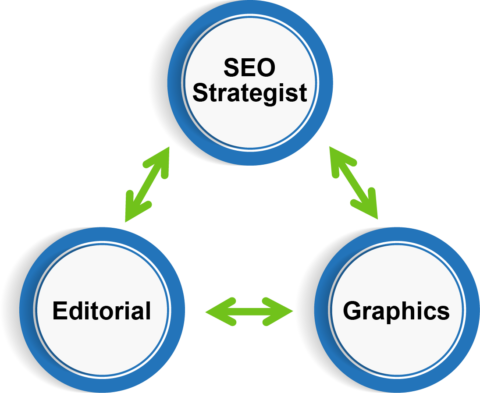
Tools to use:
- Grammarly
- SEMrush
UI / UX
User interface/user experience (UI/UX) overarches all web marketing.
Google increasingly understands the quality of experience users are having on webpages and they are rewarding sites that satisfy page experience metrics.
All page types can rank better with strong UI/UX.
Thus, the SEO team needs someone to represent the traffic upside of certain UI/UX strategies versus other needs for UI/UX.
Tools to use:
- Crazy Egg
- Hotjar
- Google Optimize
- Optimizely
Web Development
The web development team is responsible for implementing changes driven by the SEO strategist’s roadmap, designed by the UI/UX team’s guidance, and approved by ecommerce or site experience managers.
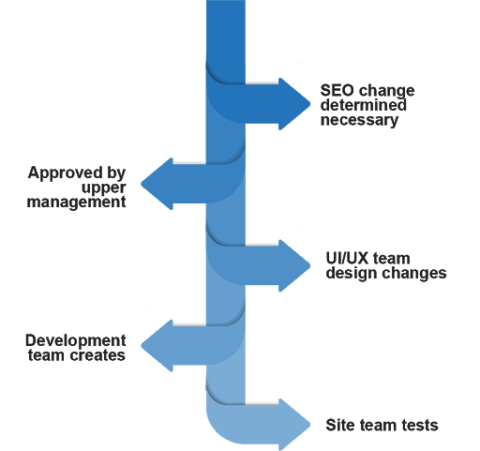
Failing to consistently clear this chain of resources is one of the biggest hindrances to success.
Analytics & Technology
By gathering historical and current performance data, the Analytics & Technology team powers the insight engine for the SEO strategy team.
In SEO, you need to look at the page level and page type, as well as brand and non-brand to understand performance.
The more you can marry those things together, along with keyword rankings, the more powerful your strategy will be.
SEO technology advancements power A/B testing, crawlability, and automation.
Tools to use include:
- Google Analytics
- Google Search Console
- Supermetrics
- BigQuery
- Tableau
- Google Tag Manager
- Google Data Studio
SEO Needs Change Over Time
As your company’s goals shift and your SEO program matures, the resources you’ll need will also change.
Here’s a hypothetical breakdown of how a company’s SEO needs can change over the span of two years.

At the beginning, the SEO strategist needs to conduct a lot of research and planning.
Most of the optimizations start with on-page work – getting the site architecture set up the way it needs to be.
As the site grows and more people work on it, the needs transition more to the execution level.
When you get out of the initial setup phases, you need the budget and resources across various activities.
The Spectrum of Ways to Get It Done
There are various ways to execute an SEO program and you’ll need to decide how to approach it.
- Should we hire more in-house staff?
- Maybe we need to add agency partners?
- Would it be best to enable our current team with software?
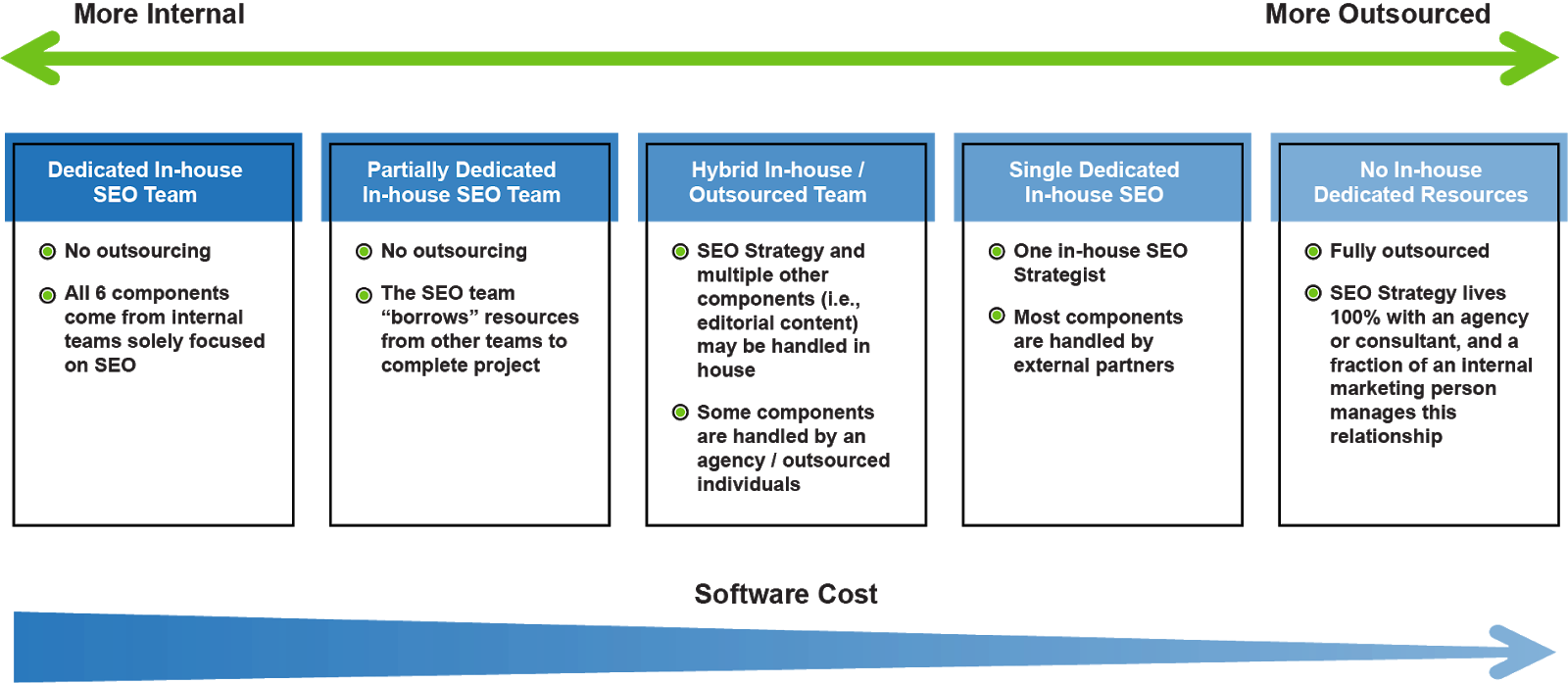
Here are some of the ways to do it:
Dedicated In-House SEO Team
- No outsourcing.
- All six components come from internal teams solely focused on SEO.
Partially Dedicated In-House SEO Team
- No outsourcing.
- The SEO team “borrows” resources from other teams to complete the project.
Hybrid In-House / Outsourced Team
- SEO strategy and multiple other components (i.e., editorial content) may be handled in-house.
- Some components are handled by an agency or outsourced individuals.
Single Dedicated In-House SEO
- One in-house SEO strategist.
- Most components are handled by an agency or outsourced individuals.
No In-House Dedicated Resources
- Fully outsourced.
- SEO strategy lives 100% with an agency or consultant, and a fraction of internal marketing person manages the relationship.
Annual Levels of SEO Investment
The greatest factor that will influence the way you structure your SEO team is how much budget you have allocated for your program annually.
<$150,000
If you have under $150,000 per year to dedicate to organic search, minimizing overhead is critical.

It is rarely wise to spend 50% or more of your budget on a full-time lead SEO strategist. It’s smart to fractionalize instead.
Resources should be focused as much as possible on creating site assets and authority to impact rankings.
With this level of budget, outsourced options are key.
$150,000 – $500,000
With this budget tier, hybridized solutions with a strong in-house SEO strategist (or two). managing specialized agency services start to look really attractive
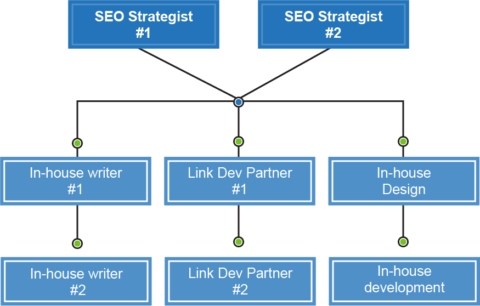
Resource allocation must be carefully assessed to determine if a dedicated team is feasible.
Flexibility is also key at this level, so having dedicated resources can limit agility.
$500,000+
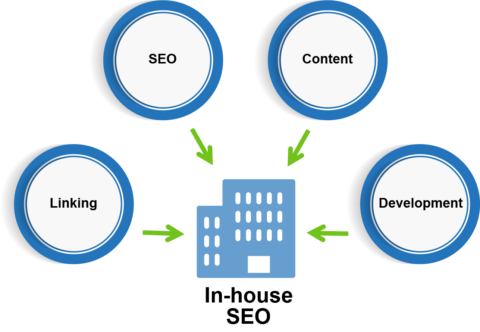
If you have $500,000+ per year to dedicate to organic search, you’re most likely familiar with investing in SEO.
You’ll want to look hard at efficiencies of bringing outsourced work in-house.
That said, you still likely need some level of outsourcing to manage bandwidth spikes.
At this point, there is a vast array of options that are open to you.
Know What Your Business Actually Needs
Every situation is unique – what works for one business won’t work for another.
Consulting with an expert can help choose the right areas to work with a partner, keep it internal, or focus budget elsewhere.

Q&A
Here are just some of the attendee questions answered by Jimmy Page and Wes Flippo.
Question (Q): My small company competes with large firms for business. How can we compete when we have a very small SEO budget compared to theirs?
Answer (A): There’s no denying that large firms are going to have an advantage in the SEO game.
Longtime internet presence has allowed these firms to develop trust signals for years, and the amount of activity around a larger brand’s site puts them in a strong position to continue to gain more authority and trust.
As a small firm, the best thing you can do is focus on what you’re good at and try to create page level assets that can outperform your competitors.
Whether it be a blog post or a service page, your content and approach need to be more in-depth and comprehensive than the sites currently ranking.
It’s smart to think about content and authority as being inversely related (in some senses). Sites with higher authority will be able to rank a piece of content due to the trust they’ve established with the search engine – but this content may not be the best piece available on the subject.
As a small brand, you’re lacking authority but can make up for it by creating a comprehensive and engaging piece of content that exceeds your competitors’.
Google also increasingly rewards sites that are tightly focused on a single topic.
Ensure the focus of your content is directly related to your product / offering or you run the risk of spreading your relevance too wide.
Keeping relevance tight will help propel rankings forward for smaller sites lacking authority.
Q: What are the optimal levels of SEO investment based on revenue size or total staff at a company?
A: The correct answer here is “it depends.” In general, trying to generalize SEO investment based on revenue or total staff can be a dangerous train of thought.
There are billion-dollar companies that should spend $0 on SEO.
For example, if you only have 3,000 target customers because you sell enterprise HR management solutions, it’s likely not necessary to have an organic presence because your sales team already has a list of every HR Director at those companies already.
Conversely, there are online businesses run by a single individual that make $500,000-$2,000,000 in annual revenue that should be investing a heavy portion of their profits back into organic search, as it makes up 80%+ of their total revenue.
Ultimately, the question shouldn’t be about total revenue size or total staff. Your investment should be based on total opportunity.
If there are searches happening around your products or services, you can identify the value of the traffic by cross-referencing with ad CPCs and estimating the total potential revenue of those clicks with opportunity modeling.
In some industries it’s simple to see the opportunity, in others it’s not as straightforward.
Do your research to understand the potential ROI on an investment and then you can answer the question of “How much should I be spending on SEO?”
Q: I’m in the medical industry, what would you recommend for the best link building strategy for that industry?
A: Linking strategy depends heavily on the size of the company.
A larger brand generally has more flexibility because there’s more activity around their website and webmasters tend to be more receptive to requests.
For a large brand, I would recommend tactics such as broken link building and unlinked brand mentions, both of which have continuous opportunity due to company size.
If you’re a smaller brand, tactics like HARO and guest post publication can prove effective.
Be careful with guest posting, though, as it can be seen as a spammy tactic if done incorrectly.
It’s important to pinpoint highly relevant sites in your industry and attempt to establish relationships with them.
In the medical industry, there’s plenty of opportunity for partnership linking.
For example, medical device companies that are sold through doctors can utilize this network of practitioners to earn backlinks on each practice’s website.
In any linking campaign it’s best to exhaust any personal/business relationships that could be linking partners first, then start outreach to cold prospects.
[Slides] Optimize Your SEO Resource Stack: Get What You Need, Get Rid of What You Don’t
Check out the SlideShare below.
Join Us For Our Next Webinar!
Google 3rd-Party Cookie Deprecation [Update] + 5 Best Strategies
Join Ryan Johnson and Andrew Miller as they explore the differences between third- and first-party cookies, analyze the profound implications of this transition for marketers, and introduce innovative solutions and strategies for what you should do next.
Image Credits
All screenshots taken by author, December 2020


